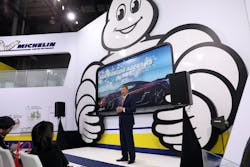Michelin North America Inc. is using its stage at the North American International Auto Show in Detroit to talk about worn tires, and the company wants tire dealers and the entire tire industry to follow its lead. Scott Clark, the new chairman and president of Michelin North America, said that the industry standard of testing the performance of only new tires simply isn't good enough. A tire's attributes change over time as the tire wears, and consumers have no way to make purchase decisions based on how the tire performs as it wears.
In the industry, safety is typically described through braking distance, and especially wet braking. Tests results show that braking performance among new tires is not equal. But Michelin's internal tests show that worn tires are even more unequal in their braking performances.
Michelin conducted internal tests that compared braking distances among specific tires in new and worn conditions to reveal how safety performance changes over time. The "worn" tires were buffed to the tread wear indicator, near the end of the tire's useful life (at 2/32-inch, as defined in many states).
The tests showed that some worn tires deliver wet-braking distances that are about the same or better than other new tires.
"This is a new insight for everyone in our industry, something Michelin believes that all of us need to start thinking about," said Clark. "What we are referring to as 'long-lasting performance' is an issue that involves consumer safety and environmental impact. Michelin is a company that thinks long-term about sustainable mobility, and we are starting a long-term discussion about performance standards for worn tires."
Making tires that offer good performance over the life the of the tire also brings other benefits — environmental and financial, Michelin said.
- Removing tires prematurely costs drivers more than $25 billion globally, accounting for increased fuel consumption and unnecessary tire purchases, according to independent research by EY.
- Early tire removal also wastes roughly 400 million tires a year worldwide, a massive impact on landfills and other end-of-life disposal networks.
Here's a video by Michelin that demonstrates the company's wet braking testing:
It was at the 2014 NAIAS that Michelin first started talking about the performance about worn tires — with the introduction of the Premier A/S tire.



